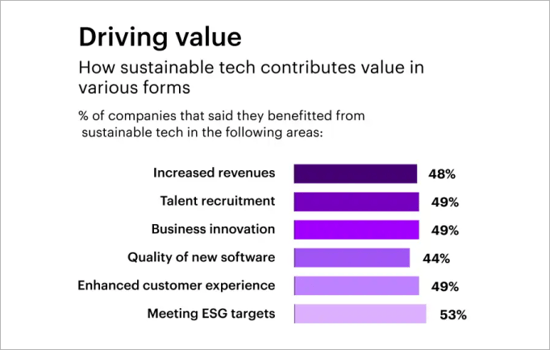Opportunity in sustainability technology
We spoke about care for the environment. The business reset for sustainable development is driven by care for the environment and the need to add business value. Here is the opportunity.
Efficiency
Businesses can be energy efficient by using the right resources in the bottom line. They can increase infrastructure utilization by taking the right steps. For instance, cloud platforms offer operational flexibility and savings as you no longer need to maintain the on-prem data centers. Office 365 study shows that IT experts reported at least 20% overall cost savings on leaving the on-prem data strategy and moving to the cloud.
While the first step towards sustainability is often to fix the infrastructure with cloud migration, there is much more to the sustainability technology equation. A few more Sustainable Technology examples are building APIs and moving toward a serverless environment, ditching the waste generated by the CPUs, and streamlining testing data environments. These are just some steps to maximize engineering efficiency and minimize infrastructure costs.
Besides, it empowers the business to collaborate in real-time for innovation, achieve effective decision-making, have transparency in processes, and set itself as an environmentally conscious business in society.
Value
Sustainability and corporates are a long-known love story. It’s a time proven that when corporates include sustainability in their operations, they are less likely to get impacted by the recession, as they have a better name in the market. Sustainable technology creates opportunities in these areas for business: internal IT, enterprise, and customer operations.
Besides, a good score on ESG brings consistent investments in your business, securing its future. Businesses are better positioned to anticipate risks and opportunities, be disposed to strategic thinking, and focus on long-term value creation.
Here are three examples from the Mckinsey Report:
-
3M has long understood that being proactive about environmental risk can be a source of competitive advantage. The company has saved $2.2 billion since introducing its “pollution prevention pays” (3Ps) program, in 1975, preventing pollution up front by reformulating products, improving manufacturing processes, redesigning equipment, and recycling and reusing waste from production.
-
Another enterprise, a major water utility, achieved cost savings of almost $180 million per year thanks to lean initiatives aimed at improving preventive maintenance, refining spare-part inventory management, and tackling energy consumption and recovery from sludge.
-
FedEx, for its part, aims to convert its entire 35,000-vehicle fleet to electric or hybrid engines; to date, 20 percent have been converted, which has already reduced fuel consumption by more than 50 million gallons.



-2.png)







